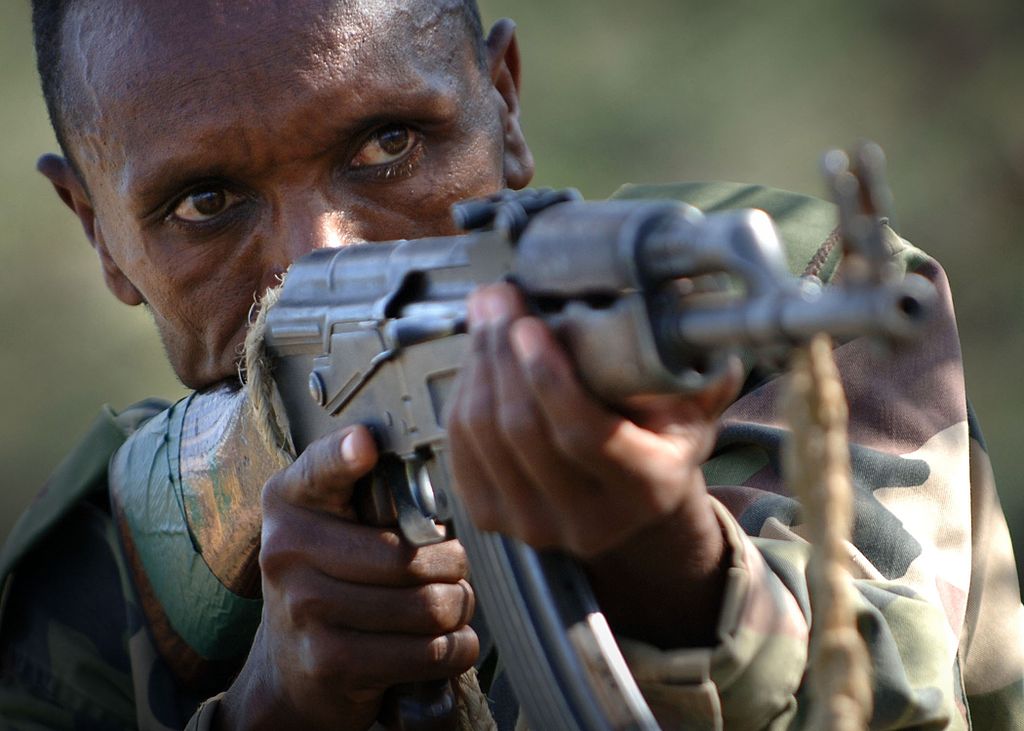
Ethiopian soldier holding an AK-47.
“The wide-ranging sanctions could have serious implications for Africa. Importantly, they could affect the continent’s ability to procure and maintain military hardware from Russia.”
Economic sanctions on Russia will likely jeopardize African countries’s ability to purchase new weapons and maintain existing stockpiles, according to the excerpted article from South African news source The Conversation Africa. As the article points out, African countries import 49 percent of its military hardware from Russia, everything from battleships and fighter jets to handguns and rifles.
The article notes five ways the sanctions on Russia are likely to impact African defense contractors and/or militaries. First, Russia cannot deliver military hardware that is already on order. Second, African militaries will struggle to maintain their vast inventories of Russian weapons because the supply of spare parts is now in jeopardy. Third, various contractual obligations between Russian arms suppliers and African nations will not be met, possibly leaving some difficult issues for courts to decide. Fourth, arms merchants from numerous countries will try to fill the void created by Russia’s absence. However, since so much of Africa’s weaponry is Russian made, it will not be easy for many African countries to replace their Russian weapons with Western armaments. Fifth and finally, the already present black market in arms transfers is likely to grow as Russia and possibly some African nations look to skirt the sanctions.
The absence of Russian weapons could also prove to be an incentive for African defense industries to increase the quantity of their output as well as try to manufacture larger and more complex weapons platforms. As the article points out, Russia might even transfer some of its defense contracts to countries such as Nigeria and South Africa, which already have a enough industrial capacity to manufacture arms.
Source:
Moses B. Khanyile, “Sanctions against Russia will affect arms sales to Africa: the risks and opportunities,” The Conversation Africa (South African independent news source), 27 March 2022. https://theconversation.com/sanctions-against-russia-will-affect-arms-sales-to-africa-the-risks-and-opportunities-180038
The wide-ranging sanctions could have serious implications for Africa. Importantly, they could affect the continent’s ability to procure and maintain military hardware from Russia.
The biggest buyers of armaments from Russia – and most long-standing importers – are Algeria, Angola, Burkina Faso, Egypt, Ethiopia, Morocco and Uganda.
In the past Russia has been astute in filling the void left by western countries. It did this in 2013 when the US cut off military aid and arms to Egypt after the military staged a coup. Suppliers such as Russia and France were happy to fill the gap.
The comprehensive sanctions imposed on Russia are likely to last beyond the current conflict. This implies that what may be regarded as ‘interim measures’ to fill a temporary void may end up being a long-lasting solution to Africa’s desire to produce its own military hardware for its own use, and also to reduce reliance on external suppliers.
African countries should therefore make a concerted effort to look towards defence companies on the continent for support. The African Union and South Africa, in particular, given its BRICS link, should play a central role in driving such a campaign.
Image Information:
Image: Ethiopian soldier holding an AK-47.
Source: U.S. government via Wikimedia, https://commons.wikimedia.org/wiki/File:Afrimil-ethiopiansoldier.jpg
Attribution: Public Domain

